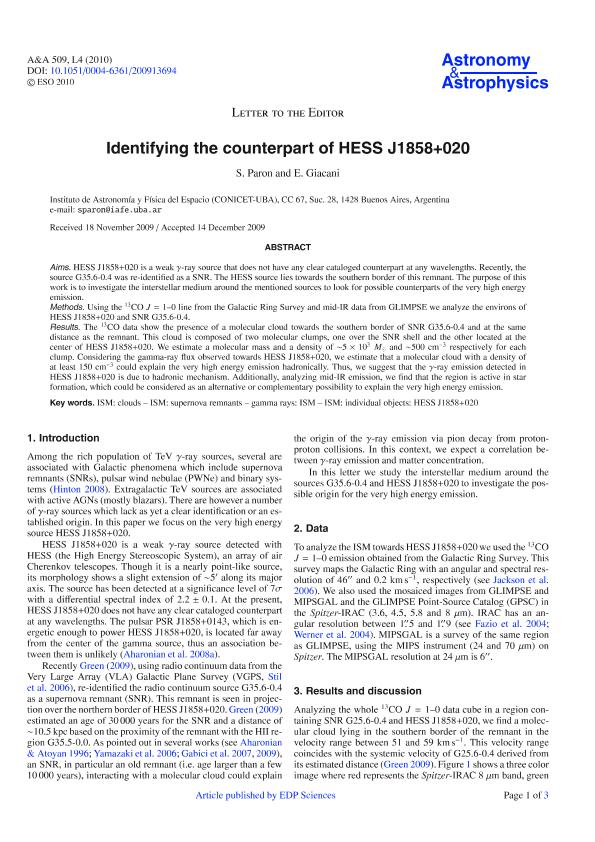Artículo
Identifying the counterpart of HESS J1858+020
Fecha de publicación:
01/2010
Editorial:
EDP Sciences
Revista:
Astronomy and Astrophysics
ISSN:
0004-6361
Idioma:
Inglés
Tipo de recurso:
Artículo publicado
Clasificación temática:
Resumen
Aims: HESS J1858+020 is a weak γ-ray source that does not have any clear cataloged counterpart at any wavelengths. Recently, the source G35.6-0.4 was re-identified as a SNR. The HESS source lies towards the southern border of this remnant. The purpose of this work is to investigate the interstellar medium around the mentioned sources to look for possible counterparts of the very high energy emission. <br /> Methods: Using the <sup>13</sup>CO J=1-0 line from the Galactic Ring Survey and mid-IR data from GLIMPSE we analyze the environs of HESS J1858+020 and SNR G35.6-0.4. <br /> Results: The <sup>13</sup>CO data show the presence of a molecular cloud towards the southern border of SNR G35.6-0.4 and at the same distance as the remnant. This cloud is composed of two molecular clumps, one over the SNR shell and the other located at the center of HESS J1858+020. We estimate a molecular mass and a density of ˜ 5 × 10<sup>3</sup> M_ȯ and ~500 cm<sup>-3</sup> respectively for each clump. Considering the gamma-ray flux observed towards HESS J1858+020, we estimate that a molecular cloud with a density of at least 150 cm<sup>-3</sup> could explain the very high energy emission hadronically. Thus, we suggest that the γ-ray emission detected in HESS J1858+020 is due to hadronic mechanism. Additionally, analyzing mid-IR emission, we find that the region is active in star formation, which could be considered as an alternative or complementary possibility to explain the very high energy emission.
Archivos asociados
Licencia
Identificadores
Colecciones
Articulos(IAFE)
Articulos de INST.DE ASTRONOMIA Y FISICA DEL ESPACIO(I)
Articulos de INST.DE ASTRONOMIA Y FISICA DEL ESPACIO(I)
Citación
Paron, Sergio Ariel; Giacani, Elsa Beatriz; Identifying the counterpart of HESS J1858+020; EDP Sciences; Astronomy and Astrophysics; 509; L4; 1-2010; 1-3
Compartir
Altmétricas




